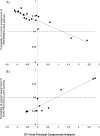Avoiding toxic levels of essential minerals: a forgotten factor in deer diet preferences
- PMID: 25615596
- PMCID: PMC4304801
- DOI: 10.1371/journal.pone.0115814
Avoiding toxic levels of essential minerals: a forgotten factor in deer diet preferences
Abstract
Ungulates select diets with high energy, protein, and sodium contents. However, it is scarcely known the influence of essential minerals other than Na in diet preferences. Moreover, almost no information is available about the possible influence of toxic levels of essential minerals on avoidance of certain plant species. The aim of this research was to test the relative importance of mineral content of plants in diet selection by red deer (Cervus elaphus) in an annual basis. We determined mineral, protein and ash content in 35 common Mediterranean plant species (the most common ones in the study area). These plant species were previously classified as preferred and non-preferred. We found that deer preferred plants with low contents of Ca, Mg, K, P, S, Cu, Sr and Zn. The model obtained was greatly accurate identifying the preferred plant species (91.3% of correct assignments). After a detailed analysis of these minerals (considering deficiencies and toxicity levels both in preferred and non-preferred plants) we suggest that the avoidance of excessive sulphur in diet (i.e., selection for plants with low sulphur content) seems to override the maximization for other nutrients. Low sulphur content seems to be a forgotten factor with certain relevance for explaining diet selection in deer. Recent studies in livestock support this conclusion, which is highlighted here for the first time in diet selection by a wild large herbivore. Our results suggest that future studies should also take into account the toxicity levels of minerals as potential drivers of preferences.
Conflict of interest statement
Figures

Similar articles
-
Can Iberian red deer (Cervus elaphus hispanicus) discriminate among essential minerals in their diet?Br J Nutr. 2010 Feb;103(4):617-26. doi: 10.1017/S0007114509992091. Epub 2009 Oct 28. Br J Nutr. 2010. PMID: 19860987
-
Seasonal and lactational changes in mineral composition of milk from Iberian red deer (Cervus elaphus hispanicus).J Dairy Sci. 2006 Feb;89(2):589-95. doi: 10.3168/jds.S0022-0302(06)72122-1. J Dairy Sci. 2006. PMID: 16428628
-
Hepatic minerals of white-tailed and mule deer in the southern Black Hills, South Dakota.J Wildl Dis. 2008 Apr;44(2):341-50. doi: 10.7589/0090-3558-44.2.341. J Wildl Dis. 2008. PMID: 18436666
-
Seasonal changes of the mineral contents in the rumen of wild Yeso sika deer (Cervus nippon yesoensis).Anim Sci J. 2012 Mar;83(3):227-31. doi: 10.1111/j.1740-0929.2011.00948.x. Epub 2011 Sep 12. Anim Sci J. 2012. PMID: 22435626
-
Safety and nutritional assessment of GM plants and derived food and feed: the role of animal feeding trials.Food Chem Toxicol. 2008 Mar;46 Suppl 1:S2-70. doi: 10.1016/j.fct.2008.02.008. Epub 2008 Feb 13. Food Chem Toxicol. 2008. PMID: 18328408 Review.
Cited by
-
Estimating Mineral Requirements of Wild Herbivores: Modelling Arctic Caribou (Rangifer tarandus granti) in Summer.Animals (Basel). 2024 Mar 12;14(6):868. doi: 10.3390/ani14060868. Animals (Basel). 2024. PMID: 38539965 Free PMC article.
-
The effect of domestication on inhibitory control: wolves and dogs compared.PLoS One. 2015 Feb 25;10(2):e0118469. doi: 10.1371/journal.pone.0118469. eCollection 2015. PLoS One. 2015. PMID: 25714840 Free PMC article.
-
Do Feed Plants Provide Sufficient Sodium, Calcium and Magnesium to Sika Deer in Japan? An Analysis Using Global Plant Trait Data.Animals (Basel). 2023 Mar 13;13(6):1044. doi: 10.3390/ani13061044. Animals (Basel). 2023. PMID: 36978585 Free PMC article.
-
Deer activity levels and patterns vary along gradients of food availability and anthropogenic development.Sci Rep. 2024 May 3;14(1):10223. doi: 10.1038/s41598-024-60079-6. Sci Rep. 2024. PMID: 38702359 Free PMC article.
References
-
- Hanley TA (1997) A nutritional view of understanding and complexity in the problem of diet selection by deer (Cervidae). Oikos 79: 209–218
-
- MacArthur RH, Pianka ER (1966) On the optimal use of a patchy environment. Am Nat 100: 603–609.
-
- Murray MG (1991) Maximizing energy retention in grazing ruminants. J Anim Ecol 60: 1029–1045.
-
- Kyriazakis I, Oldham JD (1993) Diet selection in sheep—The ability of growing lambs to select a diet that meets their crude protein (nitrogen ∼ 6.25) requirements. Brit J Nutr 69: 617–629. - PubMed
-
- Schroener TW (1971) Theory of feeding strategies. Annu Rev Ecol Syst 2: 369–404.
Publication types
MeSH terms
Substances
LinkOut - more resources
Full Text Sources
Other Literature Sources
Medical
Research Materials
Miscellaneous

